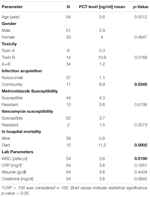Procalcitonin and infection

Extensive Selection from the smallest to the Largest Statement piece. What does procalcitonin mean? Does procalcitonin reduce antibiotic prescribing?

The use of procalcitonin guided antibiotic therapy leads to lower mortality, less antibiotic usage, decreased. The clinical value of PCT remains questionable and some hesitate to incorporate PCT into routine standard of care. Here we discuss factors limiting widespread use of PCT, particularly in the US. The greatest elevations of serum PCT are seen in bacterial infection and multiorgan failure resulting from trauma.
Under these conditions, the systemic inflammatory response, specifically the presence of inflammatory mediators such as tumor necrosis factor-alpha (TNFα), stimulates PCT production within all parenchymal tissues. The median procalcitonin level in patients with hantavirus infection was 0. A higher procalcitonin level was found in patients with hemorrhagic. CRS, tocilizumab administration, and procalcitonin were not associated with infection or severe bacterial infection.
The incidence of infection was comparable between patients who received CAR. Further, the change of PCT over time is used to determine the mortality risk in patients with bacterial sepsis. A meta-analysis was performed to evaluate the accuracy of determination of procalcitonin (PCT) and C-reactive protein (CRP) levels for the diagnosis of bacterial infection. The analysis included published studies that evaluated these markers for the diagnosis of bacterial infections in hospitalized patients.
Crucial for a successful treatment and positive outcomes, is an early diagnosis and differentiation from non-infectious causes, in order to rapidly start with antimicrobial therapy and fluid resuscitation ( ). We evaluated the value of PCT as a marker of bacterial infection for emergency department patients. The objective of this paper is to investigate the utility of serum procalcitonin (PCT) and C-reactive protein (CRP) as markers of infection in systemic lupus erythematosus (SLE) patients. Repeat PCT at hours Admission PCT 0. However, the use of procalcitonin in the diagnosis of neonatal bacterial infection is complicate but if correctly used procalcitonin in a higher specificity than C-reactive protein. In patients with lower respiratory tract infections, procalcitonin can serve as a helpful adjunct to clinical judgment for guiding antibiotic therapy and resolving diagnostic uncertainty. Procalcitonin (PCT) is a sepsis biomarker.
Recent trials have revealed the benefits of inclusion of procalcitonin in antibiotic stewardship protocols for initiation and discontinuation of antimicrobial therapy. This study aimed to investigate the association between the serum procalcitonin levels and the prognosis of patients with liver cirrhosis. During an inflammatory response, however, and especially those induced by bacterial infections, various tissues and cells can produce and release PCT into the bloodstream. Its synthesis is upregulated in bacterial infection and downregulated by viral infection.
A procalcitonin test measures the level of procalcitonin in your blood. A high level could be a sign of a serious bacterial infection , such as sepsis. Sepsis happens when an infection in one area of your body, such as your skin or urinary tract, spreads into your bloodstream.
Expression of this group of peptides is normally limited to thyroid C cells and , to a small extent, other neuroendocrine cells. As such, procalcitonin measurement on admission may be a useful marker to firstly predict patient deterioration in hospital and secondly, non-elevated procalcitonin on admission may be a good predictor of the absence of bacterial co- infection and allow the more targeted use of antimicrobials thus promoting antibiotic stewardship. Therefore, will procalcitonin solve the antibiotic overuse problem in this patient population? Although procalcitonin provides important information. PCT can be indicated in the diagnosis of bacterial infection (in particular lower respiratory tract infections) and sepsis, to assist in determining whether antimicrobial treatment should be commenced.
The procalcitonin test may be requested with other tests, when a seriously ill person has symptoms that suggest that they may have sepsis or severe bacterial infection. If you continue browsing the site, you agree to the use of cookies on this website.
Comments
Post a Comment